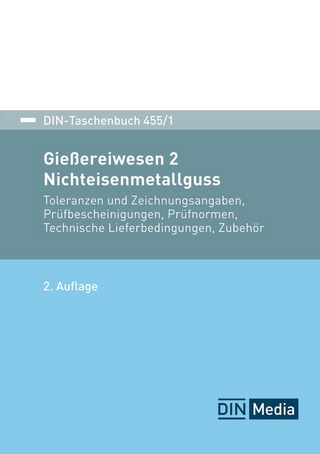
Hydraulic Fracturing Explained
Gulf Publishing Company (Verlag)
978-1-933762-40-1 (ISBN)
Rocks mechanics legend Erle Donaldson, along with colleagues Waqi Alam and Nasrin Begum from the oil and gas consultant company Tetrahedron, have authored this handbook on updated fundamentals and more recent technology used during a common hydraulic fracturing procedure. Meant for technical and non-technical professionals interested in the subject of hydraulic fracturing, the book provides a clear and simple explanation of the technology and related issues to promote the safe development of petroleum reserves leading to energy independence throughout the world.
Erle C. Donaldson is an independent consultant and managing editor of the Journal of Petroleum Science and Engineering. He was elected to the International Hall of Fame for Science in 1993. He has received a distinguished service award from the Republic of Honduras and other honors from the U.S. Department of Energy, the National Petroleum Engineering Honor Society, and the University of Oklahoma. Dr. Donaldson has written, co-authored, and served as editor on numerous articles and books. Dr. Nasrin Begum is an environmental health scientist who has evaluated environmenal risks (human health and ecological) associated with various chemicals including chemicals related to the petroleum industry. She has over 25 years of experience in toxicological and risk evaluations and has published several papers in refereed journals. She was involved in the analysis of microbial activities for improving petroleum recovery and also for decontaminating petroleum and explosive wastes. She has a Ph.D. in Environmental Health from Colorado State University and a M.S. in Plant Pathology for Oklahoma State University. She is currently working at Tetrahedron, Inc.
Dedication
Foreword
Preface
Acknowledgments
List of Figures
List of Tables
Nomenclature
Acronyms/Abbreviations
Symbols
Greek Letters
CHAPTER 1. Hydraulic Fracturing Explained
1.1 Introduction
1.2 Petroleum Hydrocarbons
1.3 Petroleum Reserves in Shale
1.4 Petroleum Demand
1.5 Achieving Production of Hydrocarbons to Meet Demand
1.6 Hydraulic Fracturing
1.7 Environmental Issues Related to Hydraulic Fracturing
CHAPTER 2. Evaluation of Gas-Shale Formations
2.1 Sedimentary Formations
2.2 Shale Formations
2.3 Multistage Fractures
2.4 Fracture Design (Frac-Implementation)
2.5 Well Design from Surface to Reservoir
2.6 Gas-Shale Reservoir Characterization
2.7 Gamma-Ray Well-Log
2.8 Density/Neutron Log
2.9 Use of Seismic Data
CHAPTER 3. Rock Mechanics of Fracturing
3.1 Introduction
3.2 Young's Modulus of Elasticity (E)
3.3 Poisson's Ratio (v)
3.4 Bulk Modulus (KB)
3.5 Shear Modulus (G)
3.6 Effective Stress
3.7 Mohr Stress Diagram
3.8 Initiation of Fractures
3.9 Propping the Fracture Open
CHAPTER 4. Fracture Fluids
4.1 Introduction
4.2 Oil-Based Fracturing Fluids
4.3 Water-Based Frac-Fluids
4.4 Alcohol-based Frac-fluids
4.5 Acid Frac-Fluid
4.6 Foams
4.7 “Slick-Water
4.8 Surfactants
4.9 Clay Stabilizers
4.10 Temperature Stabilizers
4.11 Fluid-Loss Additives
4.12 Viscosity Breakers
4.13 Biocides
4.14 Buffers
4.15 Frac-Fluid Preparation
4.16 Conclusion
CHAPTER 5. Field Implementation of Hydraulic Fracturing
5.1 Introduction
5.2 Protecting Groundwater
5.3 Waste Water Management in Hydraulic Fracture
5.4 Fresh Water Management in Hydraulic Fracturing
5.5 Reducing Surface Disturbance
5.6 Controlling Noise, Lighting, and Traffic at Fracturing Job Sites
5.7 Technical Considerations for the Success of Hydraulic Fracture Treatments
5.8 Case Studies of Hydraulic Fracturing
CHAPTER 6. Environmental Impacts of Hydraulic Fracturing
6.1 Surface and Subsurface Environmental Effects
6.2 Water Withdrawals
6.3 Surface Spills
6.4 Wastewater Management
6.5 Air Emissions
6.6 Water Impoundments
6.7 Human Health Impacts
6.8 Where to Get Toxicity Information
6.9 Chemicals Present In Hydraulic Fracturing Fluid
6.10 Chemicals Present in Flow-Back Fluids
6.11 Regulations for Protecting the Environment
6.12 Regulations Currently Applicable
APPENDIX A. Viscosity
A.1 Power-Law Fluids
APPENDIX B. Surfactants, Emulsions, Gels, Foams
B.1 Surfactants
B.2 Emulsions
B.3 Foams
APPENDIX C. Calculations
C.1 Subsurface Overburden and Horizontal Stress
C.2 Fracture Initiation Pressure
C.3 Fracture Propagation Pressure
C.4 Matrix Permeability
C.5 Fracture Size
C.6 Rock Matrix Mechanical Properties
C.7 Summary
Glossary
References
Index
| Erscheint lt. Verlag | 1.4.2013 |
|---|---|
| Verlagsort | Austin |
| Sprache | englisch |
| Maße | 156 x 234 mm |
| Gewicht | 490 g |
| Themenwelt | Technik ► Bergbau |
| Technik ► Elektrotechnik / Energietechnik | |
| ISBN-10 | 1-933762-40-3 / 1933762403 |
| ISBN-13 | 978-1-933762-40-1 / 9781933762401 |
| Zustand | Neuware |
| Haben Sie eine Frage zum Produkt? |
aus dem Bereich


